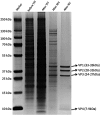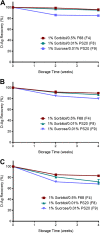Development of Thermostable Lyophilized Sabin Inactivated Poliovirus Vaccine
- PMID: 30482835
- PMCID: PMC6282204
- DOI: 10.1128/mBio.02287-18
Development of Thermostable Lyophilized Sabin Inactivated Poliovirus Vaccine
Abstract
As oral poliovirus vaccine (OPV) causes vaccine-associated paralytic poliomyelitis, the polio endgame strategy introduced by the Global Polio Eradication Initiative calls for a phased withdrawal of OPV and an introduction of inactivated poliovirus vaccine (IPV). The introduction of IPV creates challenges in maintaining the cold chain for vaccine storage and distribution. Recent advances in lyophilization have helped in finding a temperature-stable formulation for multiple vaccines; however, poliovirus vaccines have yet to capture a stable, safe formula for lyophilization. In addition, efficient in vitro methods for antigen measurement are needed for screening stable vaccine formulations. Here, we report size exclusion high-performance liquid chromatography (SE-HPLC) as a reliable means to identify the leading lyophilized formulation to generate thermostable Sabin inactivated poliovirus vaccine (sIPV). High-throughput screening and SE-HPLC determined the leading formulation, resulting in 95% D-antigen recovery and low residual moisture content of sIPV following lyophilization. Furthermore, the lyophilized sIPV remained stable after 4 weeks of incubation at ambient temperature and induced strong neutralizing antibodies and full protection of poliovirus receptor transgenic mice against the in vivo challenge of wild-type poliovirus. Overall, this report describes a novel means for the high-throughput evaluation of sIPV antigenicity and a thermostable lyophilized sIPV with in vivo vaccine potency.IMPORTANCE Poliomyelitis is a highly contagious disease caused by the poliovirus. While the live attenuated OPV has been the vaccine of choice, a major concern is its ability to revert to a form that can cause paralysis, so-called vaccine-associated paralytic poliomyelitis. Therefore, the new endgame strategy of the Global Polio Eradication Initiative includes the introduction of an IPV. However, the feasibility of the use of current IPV formulations in developing countries is limited, because IPV is insufficiently stable to be purified, transported, and stored under unrefrigerated conditions. We successfully designed the sIPV for use in the dry state that maintains the full vaccine potency in animal models after incubation at ambient temperature. This report provides, for the first time, candidate formulations of sIPV that are stable at elevated temperatures.
Keywords: D-antigen; Sabin inactivated poliovirus vaccine; cold chain; lyophilization; thermostable.
Copyright © 2018 Shin et al.
Figures




Similar articles
-
Differences in Antigenic Structure of Inactivated Polio Vaccines Made From Sabin Live-Attenuated and Wild-Type Poliovirus Strains: Impact on Vaccine Potency Assays.J Infect Dis. 2020 Feb 3;221(4):544-552. doi: 10.1093/infdis/jiz076. J Infect Dis. 2020. PMID: 30788503
-
Analysis of the dose-sparing effect of adjuvanted Sabin-inactivated poliovirus vaccine (sIPV).Hum Vaccin Immunother. 2018;14(8):1987-1994. doi: 10.1080/21645515.2018.1454571. Epub 2018 May 10. Hum Vaccin Immunother. 2018. PMID: 29601259 Free PMC article.
-
Immunogenicity of three sequential schedules with Sabin inactivated poliovirus vaccine and bivalent oral poliovirus vaccine in Zhejiang, China: an open-label, randomised, controlled trial.Lancet Infect Dis. 2020 Sep;20(9):1071-1079. doi: 10.1016/S1473-3099(19)30738-8. Epub 2020 May 19. Lancet Infect Dis. 2020. PMID: 32442523 Clinical Trial.
-
Poliovirus vaccines. Progress toward global poliomyelitis eradication and changing routine immunization recommendations in the United States.Pediatr Clin North Am. 2000 Apr;47(2):287-308. doi: 10.1016/s0031-3955(05)70208-x. Pediatr Clin North Am. 2000. PMID: 10761505 Review.
-
Risks associated with the use of live-attenuated vaccine poliovirus strains and the strategies for control and eradication of paralytic poliomyelitis.Expert Rev Vaccines. 2012 May;11(5):609-28. doi: 10.1586/erv.12.28. Expert Rev Vaccines. 2012. PMID: 22827246 Review.
Cited by
-
Thermostable bivalent filovirus vaccine protects against severe and lethal Sudan ebolavirus and marburgvirus infection.Vaccine. 2024 Jan 25;42(3):598-607. doi: 10.1016/j.vaccine.2023.12.053. Epub 2023 Dec 28. Vaccine. 2024. PMID: 38158300
-
Physicochemical properties and adsorption state of aluminum adjuvants with different processes in vaccines.Heliyon. 2023 Jul 28;9(8):e18800. doi: 10.1016/j.heliyon.2023.e18800. eCollection 2023 Aug. Heliyon. 2023. PMID: 37560692 Free PMC article.
-
Study of Oncolytic Virus Preservation and Formulation.Pharmaceuticals (Basel). 2023 Jun 5;16(6):843. doi: 10.3390/ph16060843. Pharmaceuticals (Basel). 2023. PMID: 37375789 Free PMC article. Review.
-
Current and next-generation formulation strategies for inactivated polio vaccines to lower costs, increase coverage, and facilitate polio eradication.Hum Vaccin Immunother. 2022 Dec 30;18(7):2154100. doi: 10.1080/21645515.2022.2154100. Epub 2022 Dec 28. Hum Vaccin Immunother. 2022. PMID: 36576132 Free PMC article. Review.
-
Structure-Based Optimization of ML300-Derived, Noncovalent Inhibitors Targeting the Severe Acute Respiratory Syndrome Coronavirus 3CL Protease (SARS-CoV-2 3CLpro).J Med Chem. 2022 Feb 24;65(4):2880-2904. doi: 10.1021/acs.jmedchem.1c00598. Epub 2021 Aug 4. J Med Chem. 2022. PMID: 34347470 Free PMC article.
References
MeSH terms
Substances
LinkOut - more resources
Full Text Sources
Medical
Research Materials
